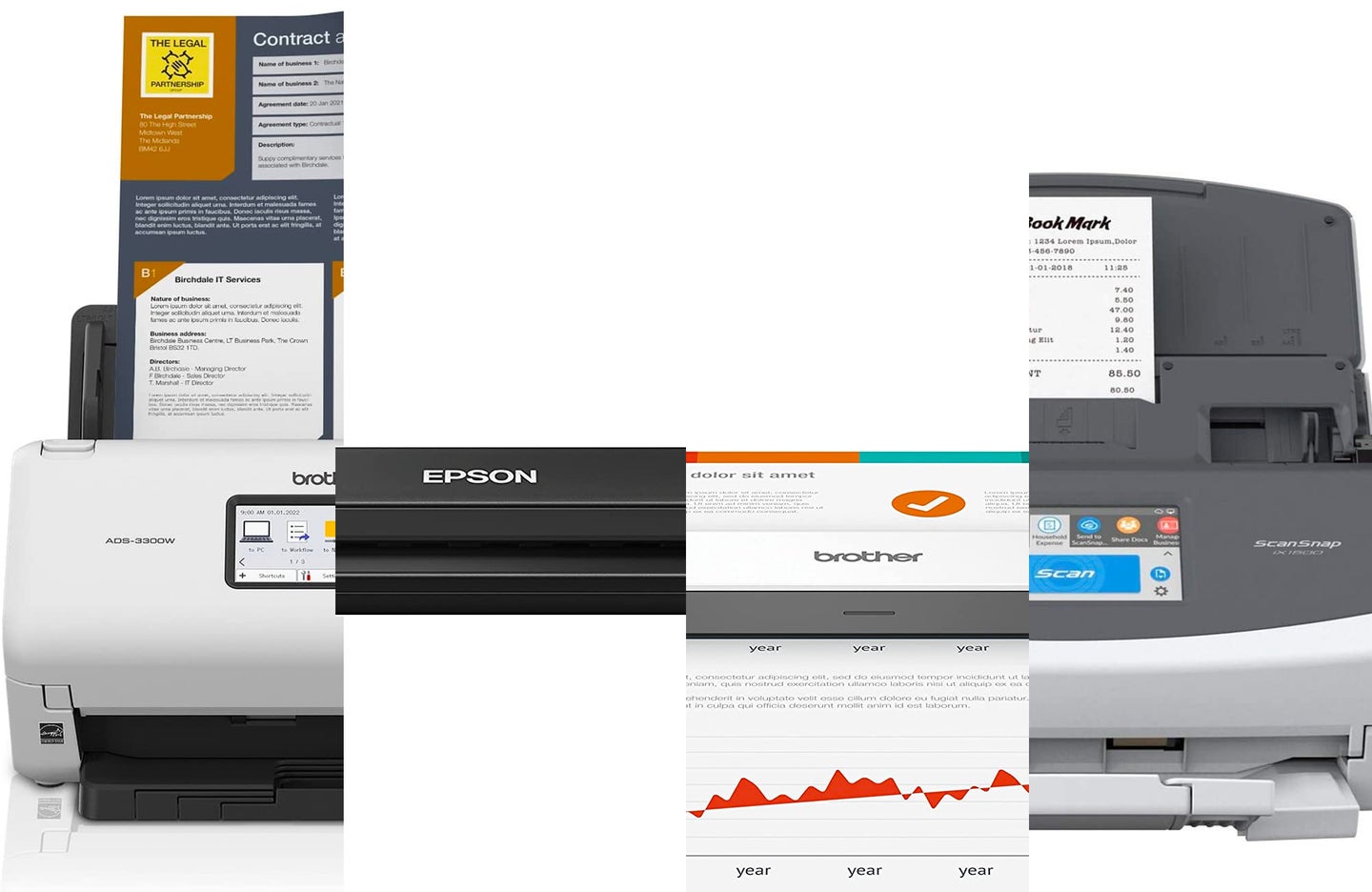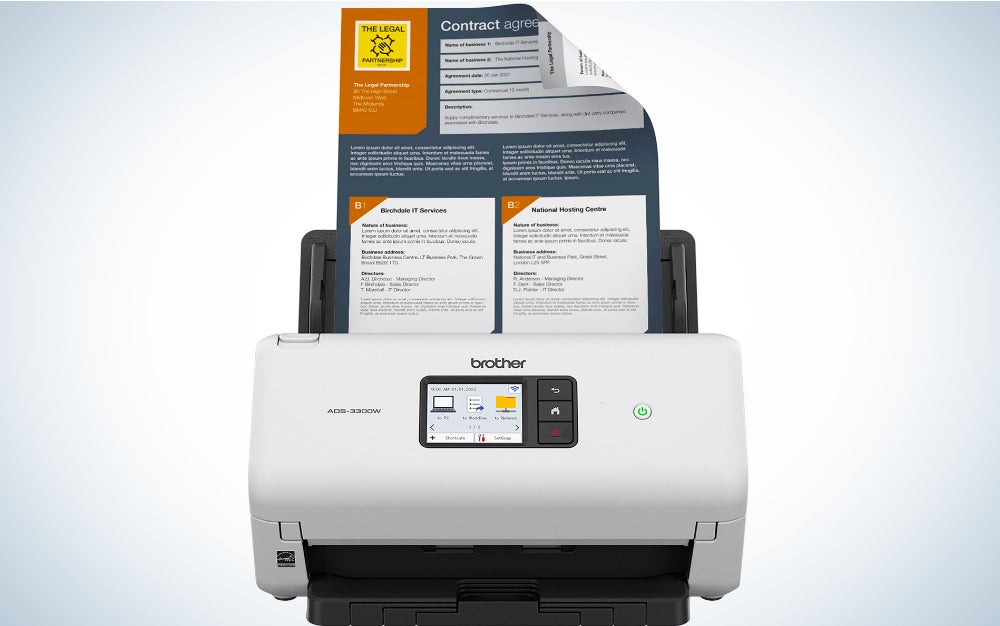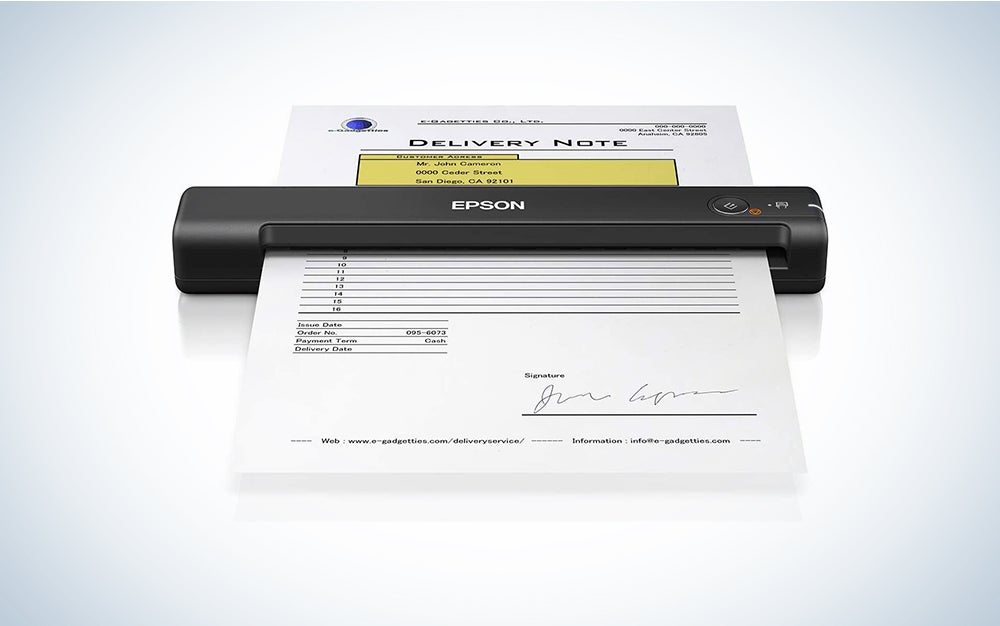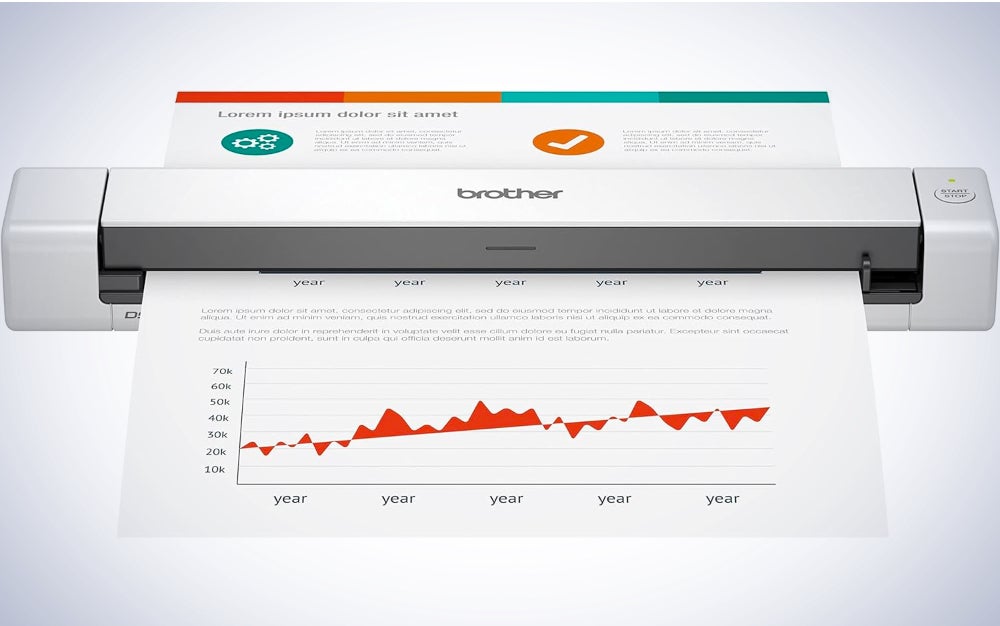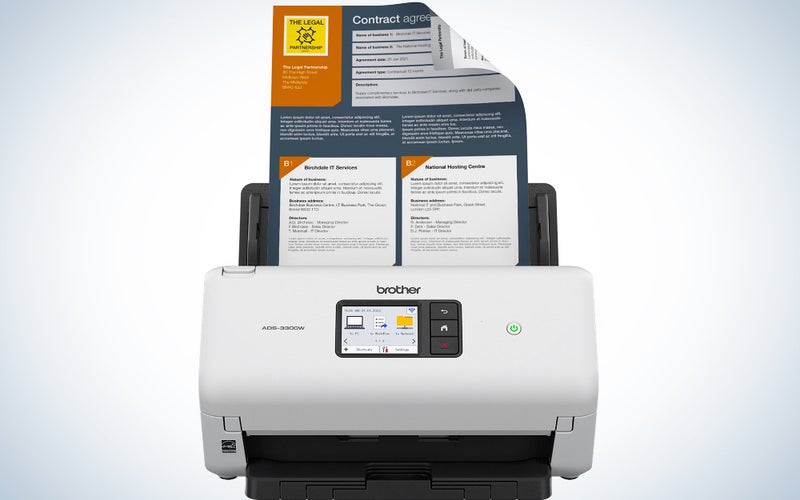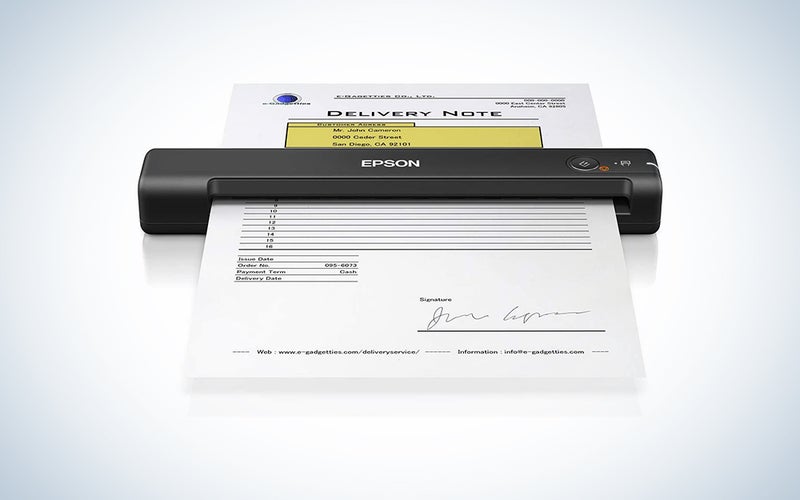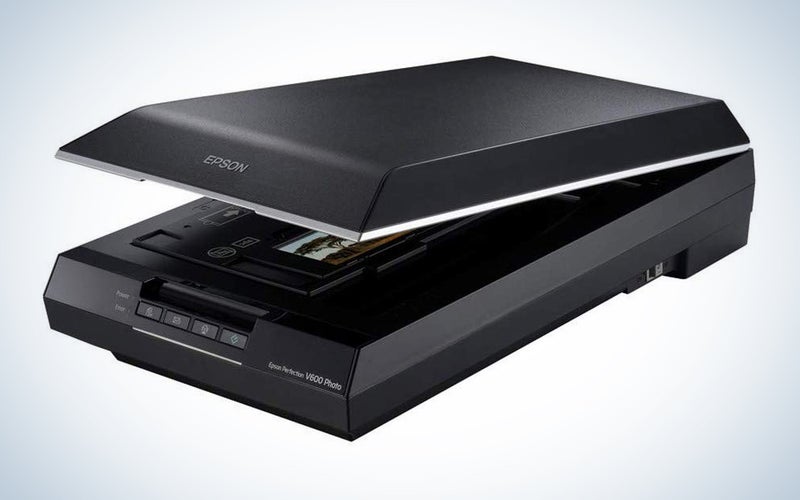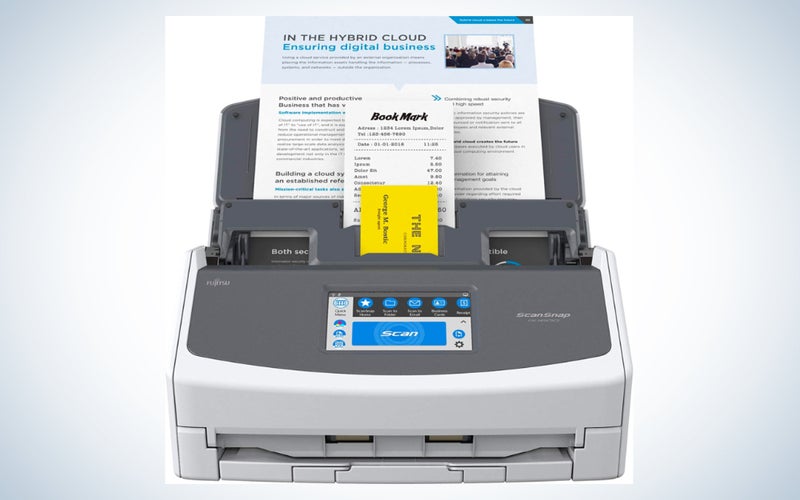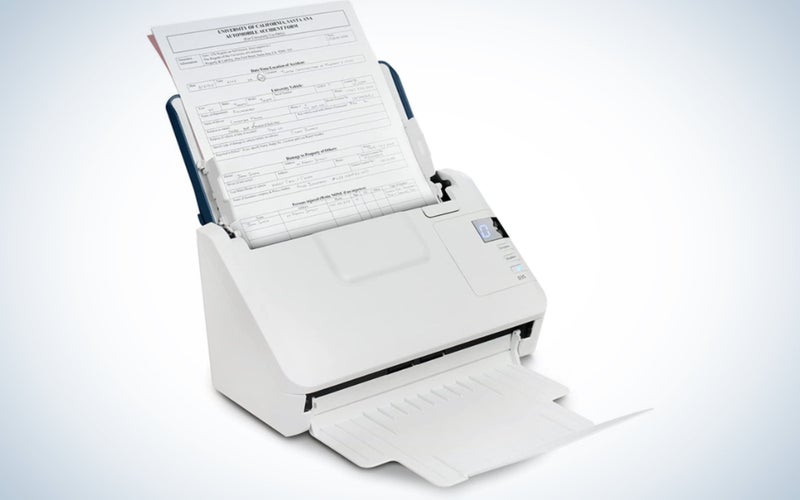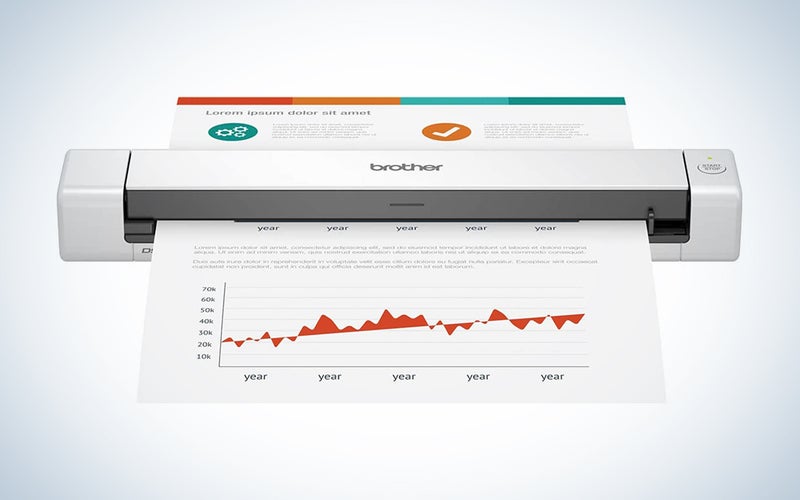We may earn revenue from the products available on this page and participate in affiliate programs. Learn more ›
Document scanners might seem straightforward, but buying the first one you see will probably leave you with a device that doesn’t do what you really need. If you’re scanning and collating documents for tax season, for example, there’s a specific scanner for you. If you’re working in a busy office or a front-facing customer service position, another one is better suited for those needs. And if your mission is to collect and perhaps enhance old family photos, having the appropriate model will make all the difference. When you’re ready to go paperless, you’ll need to consider where you plan to use this scanner, the workload you expect it to handle, and the specs of the materials you’ll send through. Some scanners handle double-sided documents in one go, while others require you to enter the file twice. To find the best document scanners for your needs, you’ll need to double-check the specs before you have one of them shipped to your door … and the best place to start is right here!
- Best overall: Brother Wireless High-Speed Desktop Document Scanner
- Best handheld: Epson WorkForce ES-50 Portable Sheet-Fed Document Scanner
- Best photo scanner: Epson Perfection V600 Color Photo, Image, Film, Negative & Document Scanner
- Best double-sided: Fujitsu ScanSnap iX1600
- Best with a feeder: Xerox D35 Duplex Document Scanner
- Best budget: Brother DS-640 Compact Mobile Document Scanner
How we chose the best document scanners
We understand that not everyone’s document scanning needs are the same, and have tailored our recommendations based on several criteria. Size is one of our largest considerations because scanners you use infrequently shouldn’t take up a lot of room on your desk. We also ensured that some of our picks catered toward photographers since images can be among the most important media on a document. And you’ll be covered if you need nice-to-have features like double-sided document scanning for increased efficiency. Just add laptop.
The best document scanners: Reviews & Recommendations
Everyone has slightly different scanning needs. Our recommendations take the most popular ones into account and cover a wide range of prices, so be sure to consider all of them before making your choice.
Best overall: Brother Wireless High-Speed Desktop Document Scanner
Brother
Why it made the cut: Brother’s ADS-3300W’s multiple functions are at the heart of its utility, and the screen on top makes it easy to access critical functions.
Specs
- Speed: 40ppm (pages per minute)
- Double-sided scanning: Yes
- Price: $349.99
Pros
- Fast speed
- Multiple scanning bays
- Touch screen
Cons
- Expensive
This Brother office scanner handles photos and documents with a resolution up to 1200 x 1200 interpolated and 600 x 600 optical. Document scanning is made easier by dual-sided scanning, while photo scanning is enhanced thanks to a number of image optimization features that can even remove blemishes.
Best handheld: Epson WorkForce ES-50 Portable Sheet-Fed Document Scanner
Amazon
Why it made the cut: If you want a scanner that you could literally take with you to and from jobs, this is the one to get.
Specs
- Speed: 11ppm
- Double-sided scanning: No
- Price: $99.99
Pros
- Thin
- Light
- Scans at a high DPI (dots per inch)
Cons
- Slow to scan
Great for scanning receipts and paper, this Epson handheld document scanner can scan documents in the blink of an eye. It also comes with helpful software that allows you to upload your scans straight to the cloud while also collating and labeling them. No batteries or power supplies here, as a handy USB connection serves as a charger.
Best photo scanner: Epson Perfection V600 Color Photo, Image, Film, Negative & Document Scanner
Amazon
Why it made the cut: This scanner’s support for multiple photo sizes is the key to its success.
Specs
- Speed: 21ppm
- Double-sided scanning: No
- Price: $299.99
Pros
- Great color scanning performance
- Slots for photos of different sizes
- Supports slides
Cons
- Size
This Epson photo scanner is great for photo enlargements as it handles photos and negatives in 6400 DPI. You’ll be able to remove scratches, dust marks, and discoloration thanks to their Digital ICE for Prints feature. The LED scanner requires no warmup and uses less energy than most traditional scanners. If you’re collecting and restoring old family photos, the Epson Perfection is perfect for you.
Best double-sided: Fujitsu ScanSnap iX1600
Fujitsu
Why it made the cut: If you tend to scan several different types of media, you can’t go wrong with Fujitsu’s ScanSnap iX1500 deluxe.
Specs
- Speed: 30
- Double-sided scanning: Yes
- Price: $680.99
Pros
- Touch screen
- Multiple scanning slots
- Cloud scan support
Cons
- Size
The Fujitsu ScanSnap is designed to scan a wide array of double-sided papers quickly while sorting them in the cloud. Great for the office, this scanner allows for the creation of profiles of multiple users so that scanned files will be sent to the appropriate location and organized by an individual’s presets. It also comes with a one-year subscription to Adobe Acrobat so that your scanned files will be automatically turned into searchable PDF files. Could you ask for more convenience?
Best with a feeder: Xerox D35 Duplex Document Scanner
Amazon
Why it made the cut: The Visioneer Xerox D35 can scan up to 45 documents in a row without any human interaction.
Specs
- Speed: 45ppm (pages per minute)
- Double-sided scanning: Yes
- Price: $256.41
Pros
- Automatic document feeding
- LED display
- Speed
Cons
- Size
The Xerox D35 is an unstoppable organization machine. Holding up to 50 pages in its automatic feeder, it scans up to 45 pages per minute so you’ll blaze through your uploads in a matter of minutes. Those scans go straight to the cloud and are automatically turned into searchable PDFs. Visioneer Acuity technology automatically improves the clarity of scanned images even when you’re dealing with imperfect originals.
Best budget: Brother DS-640 Compact Mobile Document Scanner
Amazon
Why it made the cut: If you’re looking to scan documents and photos on a budget, this Brother scanner hits the sweet spot between price and performance.
Specs
- Speed: 16ppm
- Double-sided scanning: No
- Price: $116.84
Pros
- Size
- Weight
- Price
Cons
- Slower scan speed
This compact mobile Brother scanner is great for paper documents, IDs, business cards, and receipts. Sixteen pages per minute isn’t exactly a blazing speed, but it won’t hamstring you unless you’ve got a lot of work to do. The included software suite helps optimize images and clarify text. You’ll also be able to send your work straight to the cloud, while a USB cord keeps it charged.
What to consider when looking for the best document scanners
Before you click “add to cart” on any scanner, you’ll want to consider your specific needs and goals for the device. From portable scanners to one that can handle large documents, we’re here to help you find the best option for you. For those looking for a scanner to use at home—for both work and personal—we’ve got you covered, too.
Document types
Odds are you’re looking for a scanner that handles both documents, photos, and images without much trouble. While you can easily find a specialty scanner for documents and one for photos, having the option to do both is a better value. To find a good all-around scanner, you’ll want to look for one that includes a wide range of resolutions. You’ll also want a scanner that handles double-sided documents, provides easy connectivity and comes with software that will allow you to easily collate and edit documents and photos.
Portability
Depending on what your work requires, having a portable scanner can increase your efficiency. For those of us who dive into troves of documents on the regular or end up at interviews where subjects offer up old photos, a portable option can be invaluable.
Understandably, you won’t see the range of features in a portable scanner as you would a full-size one, but there are still features you’ll want to look for. You’ll want something light and that can still scan quickly. On top of that, make sure it’s large enough to handle the kind of materials you’ll be scanning, where that’s photo or legal paper. Charging is another major factor if you’re taking your scanner on the go. USB charging is generally the standard and definitely preferable to batteries and external power supply, which may be hard to come by on the road.
Scanning resolution
One size does not fit all when it comes to scanners—especially when you’re working with photos. You may care less about the resolution if you’re just scanning black-and-white files, but if you’re scanning photos you’ll need to make sure your pick can handle a variety of photo sizes and that it can deliver high-resolution scans. Keep in mind: 6400 DPI is the highest resolution scanners can deliver. Bonus: many photo-focused scanners also come with the ability to scan negatives, which can come in extremely handy if you work in a darkroom.
Two-sided scanning
Whether you’re scanning bills, important memos, or reports, you’re almost certainly going to want a scanner that can scan them without requiring you to manually flip them over. Good double-sided scanners can deliver this feature with quick scanning and added software tools that automatically organize your materials in the cloud. Quick tip: For two-sided scanning, look for a scanner that does around 30 scans per minute.
Sheet feeder
These days, there are plenty of apps that let you scan an image or document right from your phone. But when you have to scan a mass of files, you’re going to want to be able to walk away and let the machine get the job done without your help. In this case, an automatic document feeder is the hardware you need. Make sure your feeder can hold a reasonable number of pages relative to your workload so that you won’t have to return to the machine before the job is done.
Budget
Need to keep the cost of your office equipment low? A budget scanner is a decent solution if you aren’t planning to take on a load of work. For under $100, you’ll still be able to procure a device that captures a wide array of documents at a decent speed. Many budget options do come with cloud and device integration so that your scans go straight to storage, but if you’re hoping for high-definition and color scans, you’ll have to pony up a bit more cash.
FAQs
Q: What should I look for when buying a document scanner?
What you should look for when buying a document scanner depends on what you’ll be doing with it. If you’re tackling photos, you’ll want to look for the highest definition (6400 DPI) available and a scanner that can take on a variety of image sizes. If you’re doing a moderate amount of document scanning, you should prioritize a scanner that can identify and organize documents. If you’re doing office-level scanning, you’ll want an automatic feeder, the ability to scan a wide array of documents and photos, and blazing-fast scan speeds. The fastest scanners can do hundreds of pages a minute but carry a higher price tag.
Q: How do I choose a scanner?
Choose the best document scanner by first identifying your scanning needs and your budget. Odds are you won’t need every feature that comes with the most expensive scanners. Determine how you’ll be using your scanner and look for features that will make that work easier.
Q: What is the fastest document scanner?
The fastest document scanners hit up to 150 pages per minute and 300 images per minute. (The Kodak i4850, for instance, delivers on these speeds at the cost of a small sedan!)
Q: What scanning software should I use?
Most scanners come with a disc of free scanning software, and you can check the manufacturer’s website for updated recommendations or download links. Additionally, computers come with pre-loaded software that allows you to create scans without a third-party app.
Q: How much should a scanner cost?
Scanners come at a wide range of price points, but you shouldn’t have to spend more than $300 unless you’re archiving documents and photos professionally.
Final thoughts on the best document scanners
- Best overall: Brother Wireless High-Speed Desktop Document Scanner
- Best handheld: Epson WorkForce ES-50 Portable Sheet-Fed Document Scanner
- Best photo scanner: Epson Perfection V600 Color Photo, Image, Film, Negative & Document Scanner
- Best double-sided: Fujitsu ScanSnap iX1600
- Best with a feeder: Xerox D35 Duplex Document Scanner
- Best budget: Brother DS-640 Compact Mobile Document Scanner
Remember: No matter what kind of document scanner you buy, the software it is compatible with can make a world of difference. Automatic image enhancement and file organization in the cloud can reduce the organizational work associated with scanning. But if scanning is integral to your job, it is absolutely worth something that is accurate and fast because nothing is as bad as waiting for multiple scans just to end up with blurry, unusable files.
Why trust us
Popular Science started writing about technology more than 150 years ago. There was no such thing as “gadget writing” when we published our first issue in 1872, but if there was, our mission to demystify the world of innovation for everyday readers means we would have been all over it. Here in the present, PopSci is fully committed to helping readers navigate the increasingly intimidating array of devices on the market right now.
Our writers and editors have combined decades of experience covering and reviewing consumer electronics. We each have our own obsessive specialties—from high-end audio to video games to cameras and beyond—but when we’re reviewing devices outside of our immediate wheelhouses, we do our best to seek out trustworthy voices and opinions to help guide people to the very best recommendations. We know we don’t know everything, but we’re excited to live through the analysis paralysis that internet shopping can spur so readers don’t have to.
